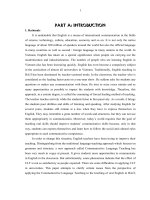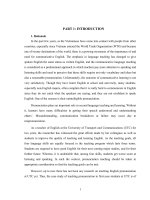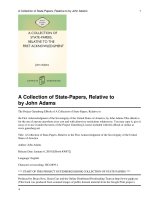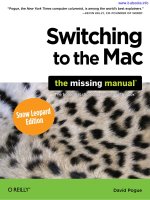Preface, freface to the first edition
Bạn đang xem bản rút gọn của tài liệu. Xem và tải ngay bản đầy đủ của tài liệu tại đây (71.28 KB, 3 trang )
6
Preface
The computing world has undergone a revolution since the publication of The C Programming
Language in 1978. Big computers are much bigger, and personal computers have capabilities
that rival mainframes of a decade ago. During this time, C has changed too, although only
modestly, and it has spread far beyond its origins as the language of the UNIX operating
system.
The growing popularity of C, the changes in the language over the years, and the creation of
compilers by groups not involved in its design, combined to demonstrate a need for a more
precise and more contemporary definition of the language than the first edition of this book
provided. In 1983, the American National Standards Institute (ANSI) established a committee
whose goal was to produce ``an unambiguous and machine-independent definition of the
language C'', while still retaining its spirit. The result is the ANSI standard for C.
The standard formalizes constructions that were hinted but not described in the first edition,
particularly structure assignment and enumerations. It provides a new form of function
declaration that permits cross-checking of definition with use. It specifies a standard library,
with an extensive set of functions for performing input and output, memory management,
string manipulation, and similar tasks. It makes precise the behavior of features that were not
spelled out in the original definition, and at the same time states explicitly which aspects of the
language remain machine-dependent.
This Second Edition of The C Programming Language describes C as defined by the ANSI
standard. Although we have noted the places where the language has evolved, we have chosen
to write exclusively in the new form. For the most part, this makes no significant difference;
the most visible change is the new form of function declaration and definition. Modern
compilers already support most features of the standard.
We have tried to retain the brevity of the first edition. C is not a big language, and it is not well
served by a big book. We have improved the exposition of critical features, such as pointers,
that are central to C programming. We have refined the original examples, and have added new
examples in several chapters. For instance, the treatment of complicated declarations is
augmented by programs that convert declarations into words and vice versa. As before, all
examples have been tested directly from the text, which is in machine-readable form.
Appendix A, the reference manual, is not the standard, but our attempt to convey the essentials
of the standard in a smaller space. It is meant for easy comprehension by programmers, but not
as a definition for compiler writers -- that role properly belongs to the standard itself.
Appendix B is a summary of the facilities of the standard library. It too is meant for reference
by programmers, not implementers. Appendix C is a concise summary of the changes from the
original version.
As we said in the preface to the first edition, C ``wears well as one's experience with it grows''.
With a decade more experience, we still feel that way. We hope that this book will help you
learn C and use it well.
We are deeply indebted to friends who helped us to produce this second edition. Jon Bently,
Doug Gwyn, Doug McIlroy, Peter Nelson, and Rob Pike gave us perceptive comments on
almost every page of draft manuscripts. We are grateful for careful reading by Al Aho, Dennis
Allison, Joe Campbell, G.R. Emlin, Karen Fortgang, Allen Holub, Andrew Hume, Dave
Kristol, John Linderman, Dave Prosser, Gene Spafford, and Chris van Wyk. We also received
helpful suggestions from Bill Cheswick, Mark Kernighan, Andy Koenig, Robin Lake, Tom
7
London, Jim Reeds, Clovis Tondo, and Peter Weinberger. Dave Prosser answered many
detailed questions about the ANSI standard. We used Bjarne Stroustrup's C++ translator
extensively for local testing of our programs, and Dave Kristol provided us with an ANSI C
compiler for final testing. Rich Drechsler helped greatly with typesetting.
Our sincere thanks to all.
Brian W. Kernighan
Dennis M. Ritchie
8
Preface to the first edition
C is a general-purpose programming language with features economy of expression, modern
flow control and data structures, and a rich set of operators. C is not a ``very high level''
language, nor a ``big'' one, and is not specialized to any particular area of application. But its
absence of restrictions and its generality make it more convenient and effective for many tasks
than supposedly more powerful languages.
C was originally designed for and implemented on the UNIX operating system on the DEC
PDP-11, by Dennis Ritchie. The operating system, the C compiler, and essentially all UNIX
applications programs (including all of the software used to prepare this book) are written in
C. Production compilers also exist for several other machines, including the IBM System/370,
the Honeywell 6000, and the Interdata 8/32. C is not tied to any particular hardware or system,
however, and it is easy to write programs that will run without change on any machine that
supports C.
This book is meant to help the reader learn how to program in C. It contains a tutorial
introduction to get new users started as soon as possible, separate chapters on each major
feature, and a reference manual. Most of the treatment is based on reading, writing and
revising examples, rather than on mere statements of rules. For the most part, the examples are
complete, real programs rather than isolated fragments. All examples have been tested directly
from the text, which is in machine-readable form. Besides showing how to make effective use
of the language, we have also tried where possible to illustrate useful algorithms and principles
of good style and sound design.
The book is not an introductory programming manual; it assumes some familiarity with basic
programming concepts like variables, assignment statements, loops, and functions.
Nonetheless, a novice programmer should be able to read along and pick up the language,
although access to more knowledgeable colleague will help.
In our experience, C has proven to be a pleasant, expressive and versatile language for a wide
variety of programs. It is easy to learn, and it wears well as on's experience with it grows. We
hope that this book will help you to use it well.
The thoughtful criticisms and suggestions of many friends and colleagues have added greatly to
this book and to our pleasure in writing it. In particular, Mike Bianchi, Jim Blue, Stu Feldman,
Doug McIlroy Bill Roome, Bob Rosin and Larry Rosler all read multiple volumes with care.
We are also indebted to Al Aho, Steve Bourne, Dan Dvorak, Chuck Haley, Debbie Haley,
Marion Harris, Rick Holt, Steve Johnson, John Mashey, Bob Mitze, Ralph Muha, Peter
Nelson, Elliot Pinson, Bill Plauger, Jerry Spivack, Ken Thompson, and Peter Weinberger for
helpful comments at various stages, and to Mile Lesk and Joe Ossanna for invaluable
assistance with typesetting.
Brian W. Kernighan
Dennis M. Ritchie









